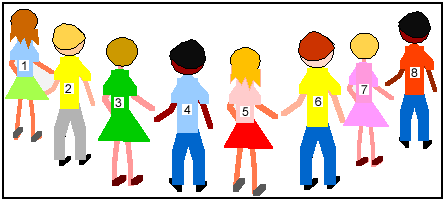Copyright © University of Cambridge. All rights reserved.
'Six in a Circle' printed from https://nrich.maths.org/
Six in a Circle
A class of $30$ children were numbered from $1$ to $30$. Here are some of the class:

Their teacher set out a ring of $6$ chairs.
Child number $1$ sat on the first chair, child number $2$ on the second chair, child number $3$ on the third and so on going round the circle, up to child number $6$. The teacher then asked child number $7$ to stand behind child $1$, child $8$ to stand behind number $2$ etc. They continued this pattern until all the children were either sitting on a chair, or standing behind
one.
How many people were standing behind each chair?
Who was standing behind child number $3$?
What would happen if there were only $4$ chairs?
Why do this problem?
This problem is a useful one when children are being introduced to, or continuing work, on multiples (and factors). It could be illustrated practically with real chairs and children holding numbered cards.
Key questions
Can you think of a good way to record this?
How about using counters numbered $1$ to $30$ or writing $1$ to $30$ on bits of paper and arranging them?
Can you think of a link to factors and multiples which may help?
Is $6$ a factor of $30$? Is $4$ a factor of $30$?
Possible extension
Learners could try with other numbers besides $6$ and $4$. If they find these problems straightforward they could try
this problem about multiples and other sets of numbers.
Possible support
Many children will find it helpful to draw out the six chairs and use numbered counters (or numbered bits of paper) to find out what happens. Encourage quick recording before the bits of paper get blown away!
